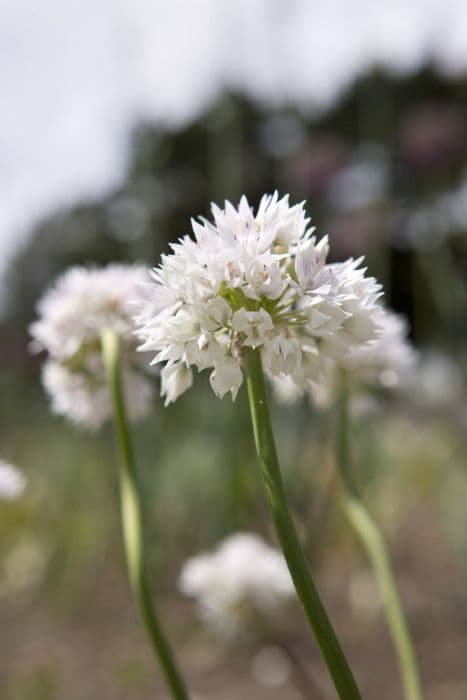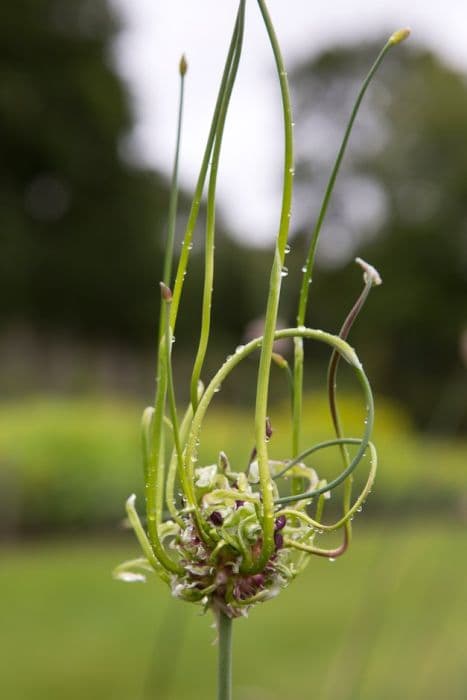Ornamental onion Allium 'Jackpot'

ABOUT
Allium 'Jackpot' is a distinctive ornamental onion featuring striking globular flower heads that create a dramatic visual impact in the garden. The flowers are composed of numerous small, star-shaped blooms tightly packed together to form a spherical cluster. These clusters typically display a deep purple hue, which adds a pop of bold color to the landscape. The leaves of Allium 'Jackpot' are typically a lush, glossy green, which may be strap-shaped or linear, forming a complementary backdrop to the vibrant blossoms. The foliage emerges from the base of the plant, creating a tufted appearance, with the flower stems rising above the leaves, showcasing the eye-catching blooms. The overall shape of the Allium 'Jackpot' is rounded and neat, making it an attractive addition to flower borders, garden beds, and as a focal point in ornamental displays. The plant is known to attract pollinators such as bees and butterflies, further enhancing its visual appeal in the garden setting.
About this plant
 Names
NamesSynonyms
Ornamental Onion, Decorative Onion, Flowering Onion, Jackpot Onion.
Common names
Allium 'Jackpot'.
 Toxicity
ToxicityTo humans
The Allium 'Jackpot', commonly known as ornamental onion, is not considered highly toxic to humans. However, if ingested in large quantities, it may cause gastrointestinal irritation, including symptoms like nausea, vomiting, and diarrhea. The plant contains compounds that can be potentially harmful, but it is typically not consumed by humans in large enough amounts to cause serious harm.
To pets
Ornamental onion is toxic to pets, especially cats and dogs. If animals ingest this plant, they may experience symptoms of poisoning such as nausea, vomiting, diarrhea, abdominal pain, excessive drooling, lethargy, and an elevated heart rate. In severe cases, ingestion can lead to oxidative damage to red blood cells, resulting in hemolysis, which could lead to anemia. It is important to prevent pets from eating any part of the Allium 'Jackpot' plant.
 Characteristics
CharacteristicsLife cycle
Perennials
Foliage type
Deciduous
Color of leaves
Green
Flower color
Purple
Height
1-2 feet (0.3-0.6 meters)
Spread
1-2 feet (0.3-0.6 meters)
Plant type
Bulb
Hardiness zones
4
Native area
Asia
Benefits
 General Benefits
General Benefits- Aesthetic appeal: Allium 'Jackpot' produces attractive spherical flower clusters that can enhance the beauty of gardens and landscapes.
- Pollinator attraction: The flowers are known to attract bees, butterflies, and other beneficial pollinators, supporting local ecosystems.
- Low maintenance: This ornamental onion typically requires minimal care once established, making it a good choice for low-maintenance gardens.
- Drought tolerance: Once established, it is relatively drought-tolerant, reducing the need for frequent watering.
- Deer and rodent resistance: The plant is resistant to deer and rodents, safeguarding your garden from unwanted animal attention.
- Versatility in landscaping: It can be used in a variety of garden styles, including borders, rock gardens, and as a statement plant in contemporary designs.
- Long blooming period: The plant has a lengthy flowering season compared to other garden ornamentals, providing extended visual interest.
- Easy to propagate: It can be easily propagated from bulbs, allowing for garden expansion or sharing with friends and fellow gardeners.
 Medical Properties
Medical PropertiesThis plant is not used for medical purposes.
 Air-purifying Qualities
Air-purifying QualitiesThis plant is not specifically known for air purifying qualities.
 Other Uses
Other Uses- Photographic Subject: Allium 'Jackpot', due to its attractive flowers, can be used as a captivating subject for photographers, especially those focusing on botanical themes.
- Natural Pest Deterrent: Planted among vegetables and fruits, the strong scent can discourage various pests from feasting on the nearby plants.
- Artistic Inspiration: Artists may use the spherical bloom structure as inspiration for sculptures, jewelry design, and other forms of art.
- Drying for Crafts: The flower heads can be dried and sprayed with paint to create long-lasting decorations for wreaths or dried flower arrangements.
- Education: Allium 'Jackpot' can be used by educators to demonstrate the lifecycle of plants and bulb growth to students in botany classes.
- Ally Planting: When planted strategically, it can serve as 'ally plants' supporting and enhancing the growth and flavor of certain vegetables and herbs.
- Culinary Display: Though not commonly consumed, the attractive flowers can be used as a garnish on plates for high-end culinary presentations.
- Clothing Dye: Historically, certain allium species have been used to produce green and yellow dyes, which could be explored with Allium 'Jackpot'.
- Garden Sculpture: When trimmed and maintained, Allium 'Jackpot' can be grown and cut to form natural garden sculptures.
- Seed Collection: Gardeners may collect the seeds of Allium 'Jackpot' for future planting or for sharing with fellow horticulture enthusiasts.
Interesting Facts
 Feng Shui
Feng ShuiThe Allium, commonly known as ornamental onion, is not used in Feng Shui practice.
 Zodiac Sign Compitability
Zodiac Sign CompitabilityThe ornamental onion is not used in astrology practice.
 Plant Symbolism
Plant Symbolism- Prosperity: The variety name 'Jackpot' suggests the idea of winning and wealth, making it associated with prosperity and good fortune.
- Strength and Courage: Alliums in general are known for their sturdy stems and robust blooms, which can symbolize resilience and the courage to stand tall.
- Unity and Humility: The globe-like shape of the Allium bloom can represent unity, with each individual floret contributing to the whole, and a reminder of the importance of being part of a community.
- Purity and Perfection: The often pristine and geometrically pleasing form of the Allium flower may symbolize the quest for purity and perfection in various aspects of life.
 Water
WaterOrnamental alliums, like Allium 'Jackpot', should be watered once a week, providing about 1 inch of water each time. This can be done either by rainfall or manual watering. To ensure deep watering, which promotes strong root growth, provide about 0.6 gallons for a small garden area. During hot and dry periods, watering frequency may need to increase to maintain moisture, but always allow the soil to dry out slightly between waterings to prevent rot. It's best to water the plant early in the morning to allow the foliage to dry out during the day, reducing the risk of disease.
 Light
LightAllium 'Jackpot' thrives best in full sunlight. This plant should be placed in a spot where it can receive at least 6 to 8 hours of direct sunlight each day. Full sun exposure ensures the best bloom and sturdy plant growth. Avoid planting in heavily shaded areas as this can lead to poor flowering and weak stems.
 Temperature
TemperatureAllium 'Jackpot' prefers a temperature range that is typical of most temperate climates. These plants can survive minimum temperatures down to about 20 degrees Fahrenheit, but the ideal growing temperatures range from 60 to 70 degrees Fahrenheit. Extreme heat or cold can stress the plant, with prolonged exposure to temperatures outside of this range potentially causing damage.
 Pruning
PruningPruning Allium 'Jackpot' is not usually necessary for the health of the plant, but spent blooms should be deadheaded after flowering to maintain a neat appearance and prevent self-seeding. Cut back the foliage only after it has died back naturally in late autumn or early winter. This ensures that the plant can photosynthesize for as long as possible and store energy for the next growing season.
 Cleaning
CleaningAs needed
 Soil
SoilOrnamental onions (Allium 'Jackpot') thrive in well-draining soil with a mix of loam, sand, and compost for nutrients. A pH level of 6.0 to 7.0 is ideal for this variety to flourish.
 Repotting
RepottingOrnamental onions like the Allium 'Jackpot' are generally repotted every 2 to 3 years or when they outgrow their current pot, which is often noticeable when roots begin to crowd.
 Humidity & Misting
Humidity & MistingOrnamental onions such as Allium 'Jackpot' prefer average garden humidity and do not require high humidity environments to grow healthily.
 Suitable locations
Suitable locationsIndoor
Place in bright light, well-draining soil, water moderately.
Outdoor
Plant in full sun, well-drained soil, and space bulbs apart.
Hardiness zone
4-8 USDA
 Life cycle
Life cycleAllium 'Jackpot', commonly known as ornamental onion, begins its life cycle when a gardener plants a bulb in well-drained soil, usually in the fall. The bulb then initiates roots and may establish some foliage before winter dormancy halts growth. With the arrival of spring, renewed warmth and moisture trigger the bulb to resume growth, sending up tall green shoots and eventually blooming with spherical clusters of small, star-shaped flowers atop sturdy stems in late spring or early summer. After flowering, the plant sets seed, and as the seeds mature, the foliage begins to die back as the plant enters a period of dormancy. The bulb remains dormant through the summer and may split or produce offsets, which can be separated to propagate new plants. In the next growing season, these bulbs will then start the cycle anew, continuing the generation of Allium 'Jackpot' in the garden.
 Propogation
PropogationPropogation time
Spring to Summer
Allium 'Jackpot', more commonly known as ornamental onion, is a plant that is typically propagated by division, which is the most popular method for this plant. Propagation by division is ideally done in either spring or autumn. The process involves gently digging up the clump of bulbs and carefully separating them from the main plant. Each division should have at least one or two bulbs attached to ensure a good start. After dividing, the individual bulbs can be replanted at a depth of about 3 inches (approximately 7.6 centimeters) into well-draining soil, ideally situated in a location that receives full sunlight to partial shade. It is essential to water the newly planted bulbs sufficiently to help establish their roots. This method capitalizes on the natural reproductive strategy of the plant and usually ensures healthy, genetically identical offspring.








